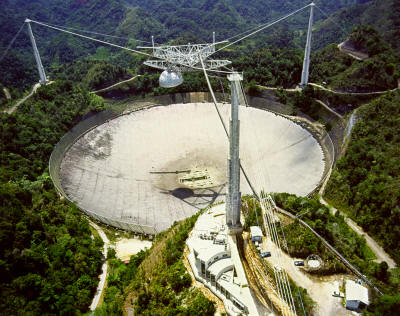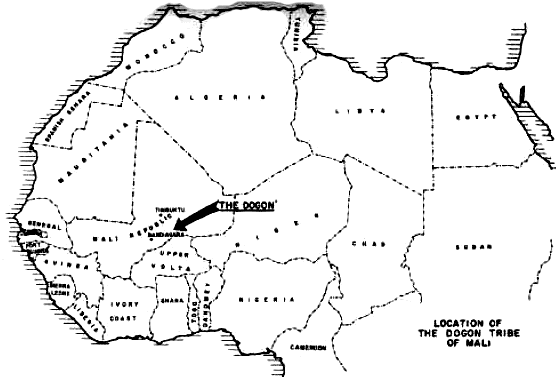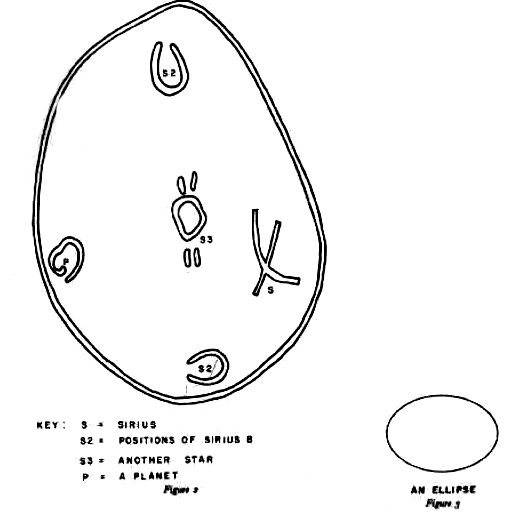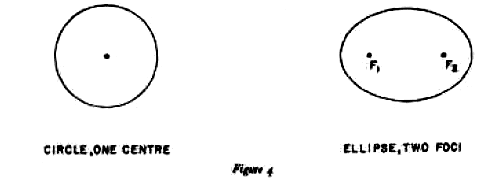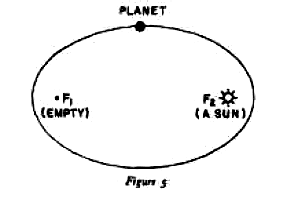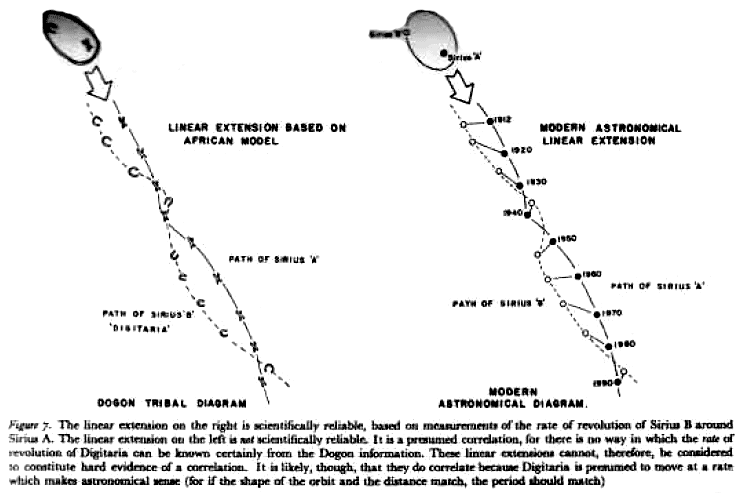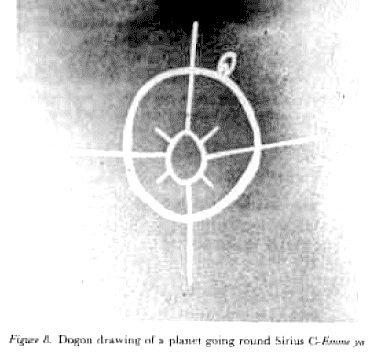|
But an intelligent astronomer will tell
you that perhaps the stars
Tau Ceti or
Epsilon Eridani, which are
rather similar to our sun, have planets with intelligent life. It
would be a good guess. But among the stars most frequently discussed
as possibly harboring intelligent life, Sirius is not included. It
is not a particularly 'obvious' choice.
Project Ozma only listened to these two stars to see if any signals were coming from them on a certain wavelength at a certain time with a lot of energy behind them. Nothing happened. Later such attempts have more realistically widened their scope somewhat, but the astronomers are fully aware that they are waltzing in the dark, and their efforts really take on the nature of a gesture which can only be described as bravado in the face of enormous odds. They cannot be certain that they are going about the task in the right way, but are doing what they hope is their best.
Since Project Ozma, the giant radio telescope at Arecibo in Puerto Rico, which is the largest in the world, has listened selectively to several stars - but not to Sirius. It is the author's hope that the evidence presented in this book will be sufficient to stimulate an astronomical investigation of the Sirius system more thorough than all those to date, and build on the recent studies by Irving Lindenblad.2
I also believe that a program should be
instituted at a major radio telescope to listen to the Sirius system
for indications of any possible intelligent signals.
* A cubic
foot of the matter of Sirius B would weigh 2,000 tons. A match-box
full of matter from the star would weigh a ton and a quarter. But a
match-box full taken from the star's core would weigh approximately
50 tons. The star it 65,000 times denser than water, whereas our own
Sun has a density about equal to that of water.
It is made out of what is called
'degenerate' matter or 'superdense' matter, where the atoms are
pressed together and the electrons squashed. This matter is so heavy
that it cannot be thought of in any familiar terms. There is nothing
in our solar system, to our knowledge, comparable to this stuff. But
physicists have considered it theoretically, and in this century we
are making some progress towards understanding it.
At the moment, as this book goes to press, a study of Sirius B is being carried out by Dr Paul G. Murdin of the Royal Greenwich Observatory, who is trying to measure the light from the tiny star.
He had still had no success by early 1974 when he and I entered into correspondence. Murdin has informed me that another astronomer, D. Lauterborn, believes there is a third star in the Sirius system.8 Murdin adds:
Lindenblad's evidence is conclusive as far as it goes, but it is not at all clear that no Sirius C exists. This is an interesting point for further study, and may require observations of longer than Lindenblad's seven years (which were taking place during the seven years I was preparing this book).
As Lindenblad has written to me:
But also like Jacob, the seven years may
be just a prelude.
In a very sensible chapter called 'Possible Consequences of Direct Contact' Sagan says:10
This is a very interesting prelude to our own story, and I believe Sagan and Shklovskii's attitude is broadly true of the entire astronomical profession. I have certainly never met an astronomer of today who seriously doubted that there must be countless numbers of intelligent civilizations scattered throughout the universe on other planets which are orbiting around other stars.11
Any people who still believe human beings are unique as intelligent life in the universe are seriously out of touch with reliable and informed estimates by scientists and astronomers. An attitude which asserts that man is the only intelligent life form in the universe is intolerably arrogant today, though as little as twenty years ago it was probably common belief.
But anyone who holds such an opinion
today is, fortunately for those who like to see some progress in
human conceptions, something of an intellectual freak equivalent to
a believer in the Flat Earth Theory. I mention that theory because I
once met a woman who appeared quite sane and yet who was a member of
a cult who believe the Earth is flat. This was one of the more
startling experiences anyone can have, and a salutary education to
me. It taught me never to underestimate the power of the human mind
to believe what it wants to believe despite any amount of evidence.
Dr Su-Shu Huang of the Goddard Space Flight Center, Maryland, has written:
Dr A. G. W. Cameron, Professor of Astronomy at Yeshiva University, has discussed the stars Tau Ceti and Epsilon Eridani, which are considered the two likeliest localities for intelligent life within our immediate neighborhood of space (within five 'parsecs' of us, a parsec being an astronomical unit of distance). He has then said, however:
Dr R. N. Bracewell of the Radio Astronomy Institute, Stanford University, has said:15
There is no need for me to continue marshalling quotations from distinguished scientists and astronomers in support of the possibility of intelligent life in space, as the situation is by now obvious. The odds against intelligent life occurring fairly frequently within our galaxy are impossible ones.
Since this is established, we are faced with yet another factor: in our own history, technological development has been rapid within a short space of time.
When civilizations all over the universe reach 'take-off point', they have a technological explosion. It is familiar to older members of our species today that when they were young there were no airplanes, automobiles, rockets, satellites, electricity, radio, or atom bombs. People were dying of diseases which today we do not take seriously, no one with a toothache could obtain modern dental treatment, the concept of elementary hygiene was a novelty. I am not reciting all these wonders merely as a ritual incantation to our new god of progress.
The point to be grasped is the sudden
combustible nature of progress of this kind. In the lifetime of a
single person all this can come about.
Once intelligent societies reach take-off point, they rush so quickly upward in technological competence that a comparison between them and non-technological societies is almost absurd. It would be foolish for us to suppose that any society more advanced than ours would be just a few years ahead of us. It would more likely be just a few tens of thousands of years ahead of us.
And the technology and nature of such a society are beyond our abilities to imagine. The intelligent societies existing in the universe, then, are going to be of two kinds: less advanced than ourselves, 'primitive'; and fantastically more advanced than ourselves, 'magical'.
To be at the point where we are now, at
the watershed between 'primitive' and 'magical', is such a rare
event in the universal history, that we may be the only intelligent
society in the entire galaxy which is at this moment experiencing
such a stage in our evolution. We therefore should feel privileged
to be witnesses of it. Of course, the nature of time comes in again
with the impossibility of talking sensibly about simultaneity in the
galaxy at all. But that is another subject, and one which we may
ignore here.
But they cannot send or receive messages between the stars. In our transition stage, aptly enough, we can receive such messages with existing equipment, but could not send any unless we constructed expensive and special means to do so. Now that means that the only societies carrying on an interstellar dialogue of any kind are the 'magical' societies.
These societies will be so advanced that
they probably have emerging primitives like ourselves 'taped'. They
certainly have standard sets of procedures for dealing with the
likes of us, and may already have commenced their operations with
the long-range intent of bringing us into their club. But just as no
London gentlemen's club wishes to have a savage in a g-string waving
his spear and poisoned arrows about in the members' lounge, so the
interstellar club is unlikely to plug us straight into the circuits
as a fully-fledged member.
And if that is the case, then our own planet, which any half-witted extraterrestrial astronomer in the neighborhood could assume as a likely place for life to exist, has almost certainly been physically visited by extraterrestrials in their travels.
This could have happened at any time in our lengthy history as a planet. No doubt, at the very least, our distant ancestors the cave-men would have been observed by extraterrestrial probes, who would have made a note that something was happening on this planet slowly happening, but nevertheless actually happening.
And as Sagan and Shklovskii said in the quotation from their book:
If this were so, it would certainly have left some impact upon man and been incorporated somehow into his traditions. But if several thousand years had elapsed between that time and the present, the traces of the impact on man's culture would have been mostly dissipated and, it would seem, nearly impossible to elucidate. Unless some specific and unmistakable survival were found to exist, in circumstances which would probably be unusual, it seems that the hope of reconstructing scattered clues and fragments of the original tradition would be futile.
That there would be something there if you could find the key seems certain.
Let us return to a continuation of that passage from Sagan and Shklovskii for suggestions as to how a memory of an extraterrestrial contact might have been preserved from prehistoric or early historic times on Earth, through comparison with a verifiable story of French contact made with certain American Indians in 1786, as it was told to a modern anthropologist in the form of a tribal myth :17
As another example, the people of
sub-Saharan Africa, who had no written language until the colonial
period, preserved their history primarily through folklore. Such
legends and myths, handed down by illiterate people from generation
to generation, are in general of great historical value.
Sagan goes on to discuss some fascinating creatures credited with founding the Sumerian civilization (which sprang up out of nowhere, as many Sumerian archaeologists will unhappily admit).
They are described in a classical account by Alexander Polyhistor as amphibious.
He says they were happier if they could go back to the sea at night and return to dry land in the daytime. All the accounts describe them as being semi-demons, personages, or animals endowed with reason, but they are never called gods.
They
were 'superhuman' in knowledge and length of life and they
eventually returned in a ship 'to the gods' carrying with them
representatives of the fauna of the earth. I discuss these
traditions particularly in Chapter Eight, and the surviving accounts
of them are to be found in Appendix II, reprinted here in their
entirety for the first time since 1876.
The Akkadians and the Sumerians intermingled and eventually formed a meld like that which now exists between what once were the separate Normans and Anglo-Saxons in Britain, except that the Akkadians were Semitic and the Sumerians were not, and with considerable physical differences between them. Then the city of Babylon with its Babylonians and the region of Assyria with its Assyrian warriors to the north - and later the distant region of Fars with its Persians to the east - commanded the Mesopotamian area.
From the Sumerian-Akkadian milieu also
evolved those Semites known as Hebrews or Jews.
Now the peoples of sub-Saharan Africa are the source of our first arresting information. The particular people are called the Dogon, and they live in the present state of Mali. The nearest cities to them are Timbuctoo, Bamako, and Ouagadougou in Upper Volta. Initial research by me on the Dogon turned up an article in an anthropological journal by the French anthropologists Marcel Griaule and Germaine Dieterlen.19
The article was written in French and an English translation of it is published, for the first time, as sequel to Part One of this book. I decided to publish the article in full because of the difficulty most interested readers would find in locating the French journal in which the original article appeared. And, of course, the original article could only be read by those who know French.
The complete article, with its footnotes
and all its illustrations, and in English, is therefore available
for anyone who wishes to read it for himself. It is thus not
necessary for me to summarize its contents.
But even in saying this, Griaule and Dieterlen imply that Sirius B is only 'virtually invisible', whereas we know it is totally invisible except through a powerful telescope.
What, then, is the answer?
Griaule and Dieterlen make clear that the large and bright star of Sirius is not as important to the Dogon as the tiny Sirius B, which the Dogon call po tolo (tolo meaning 'star'). Po is a cereal grain commonly called 'fonio' in West Africa, and whose official botanical name is Digitaria exilis.
In speaking of the po
star, Griaule and Dieterlen call it 'the star Digitaria', or just
simply 'Digitaria'. What is significant about the po grain is
that it is the smallest grain known to the Dogon, being extremely
minute, and unknown as food in Europe or America. To the Dogon, this
tiny grain represents the tiny star, and that is why the star is
called po, after the grain.
Now, this is a most unsettling statement.
The casual reader may not notice just how unusual it is for an African tribe to put it quite this way. But the orbit of Digitaria, which the Dogon elsewhere describe as egg-shaped or elliptical (see also Figures 6 and 7, as well as the illustrations to the article), is specifically described as having the main star Sirius as 'one of the foci of [its] orbit'.
Of course, the technical term 'focus' has here been supplied by the anthropologists. But they were faithfully rendering the meaning of what the Dogon said in their own language. And what the Dogon were saying, and which they also make quite clear graphically in their drawings (see Figures 2 and 6), is that the orbit of Sirius B around Sirius A is of a kind which obeys one of Kepler's laws of planetary motion, extended to other orbiting bodies.
It was Johannes Kepler (1571-1630) who first proposed that heavenly bodies do not move in perfect circular paths.
He hit upon the brilliant insight that
the planets in their motions around the sun were moving in
elliptically shaped orbits, with the sun at one of the two foci of
each ellipse. Most people I speak to have no idea that the planets
don't go in circles around the sun. Even if they were taught the
truth at school, they have long since forgotten about things like
that. And many people honestly don't know what an ellipse is unless
you show them one.
These two fragments of centre each then have the name of focus, and the two together are 'the foci of the ellipse.' If you could get your hands on that ellipse and push at the bulging ends, you might force it back together again and make it a proper circle.
But what I ask all readers to take note of is this:
But no.
They knew too much to make a mistake like that. For the whole point about Kepler's Law is that not only are the orbits ellipses, but the sun must always be at one of the foci; otherwise nothing will work. Now, in order to know about all this, you need not have had Kepler.
Elliptical orbits are a universal truth, as true here as they are on the other side of the galaxy, or even in some other galaxy. Kepler merely discovered a natural principle. He didn't invent it. So there was no need for the Dogon to know about Kepler personally. All that is required is an explanation of how they could have learned the universal principle from any other source, considering that they exist on this planet, and we don't know of anyone else on this planet, living in Africa, say, who has discovered any of these things.
In Fig. 6 below, I compare the Dogon drawings of the orbit of Sirius B around Sirius with the modern astronomical diagrams of the same (which have just been confirmed as accurate at this scale by Lindenblad's latest work); also there is a comparison of the same information, tribal and modern, as seen in a linear perspective, stretched through time. I do not need to claim any perfect scientific accuracy for the Dogon drawings.
The similarity is so striking that the most untrained eye can immediately see that the general picture is identical, in each instance. There is no need for perfectionists to get out their slide rules or measuring tapes.
The fact is demonstrated, and it is that the Dogon have an accurate general knowledge of the most unobvious and subtle principles of the orbiting of Sirius B around Sirius A.
The Dogon also know the actual orbital period of this invisible star, which is fifty years. Referring to the sacred Sigui ceremony of the tribe, Dieterlen and Griaule tell us:
The Dogon also say that Sirius B rotates on its axis, demonstrating that they know a star can do such a thing. In reality, all stars really do rotate on their axes. How do the Dogon know such an extraordinary fact?
In the article, the Dogon are recorded as saying:
It is not known to modern astronomy what the period of rotation of Sirius B is; the star is so small we think we are doing well to see it at all.
I asked one astronomer, G. Wegner,
of Oxford's Department of Astrophysics and the University
Observatory, whether one year might be a sensible estimate of the
rotation period of Sirius B. He naturally replied that we had no way
of determining it, but that a year could be right; in other words,
it cannot be ruled out, which was all I was seeking to establish.
But what is really the most amazing of all the Dogon statements is this:
So we see the Dogon presenting a theory of Sirius B which fits all known scientific facts, and even some which are not known it presents as well. They know that the star is invisible, but they know it is there nevertheless. They know that the star's orbital period is fifty years, which it really is. They know that Sirius A is not at the centre of its orbit, which it is not.
They know that Sirius A is at one of the foci of Sirius B's elliptical orbit, which it is. They know that Sirius B is the smallest kind of star, which it is (barring totally invisible collapsing neutron stars). They know that Sirius B is composed of a special kind of material which is called sagala, from a root meaning 'strong', and that this material does not exist on the earth.
They know that this material is heavier than all the iron on earth, etc., all of which is perfectly true. For Sirius B is in reality made of super-dense matter of a kind which exists nowhere on earth.
All this forms the most sacred and most secret tradition known to the Dogon, the basis of their religion and of their lives. Connected with all this are statements they make about the existence of a third star in the Sirius system, which they call the emme ya star which, in comparing it to Digitaria, they say is,
This last star has a satellite, indicating that the Dogon appreciate that bodies other than stars are satellites of stars.
Of emme ya itself, they say:
Around the astronomical facts of this
extraordinary system, the Dogon have a complicated system of
mythology. Sirius B they see as 'relentlessly revolving around
Sirius . . and never capable of reaching it'. All these facts have
mythological tales and personages connected with them. I have tried
to extract the bare facts from the article and present them here for
the reader. But the reader will by now see quite clearly why I have
included the entire article in this book, for the information is so
incredible that I thought the reader would simply think I had made
it all up unless I presented the source for him to read through
himself.
Let us now consider a later and fuller publication of book length, which is obviously too bulky to include within this book as an appendix. I refer to the book Le Renard Pale (The Pale Fox) published in 1965. This book, by Griaule and Dieterlen, was produced ten years after the death of Marcel Griaule himself.
It contains Mme Dieterlen's latest reflections on the Sirius system of the Dogon. In this definitive compendium20 of much of the joint findings of herself and Marcel Griaule (it is only the first such volume of theirs to appear in a planned series summing up their work), Mme Dieterlen has actually added a brief appendix on pages 529-31 which gives information about Sirius and its companion star in the form of an extract from an article by Dr P. Baize which appeared in the September 1931 issue of Astronomic.
She says:
Her curiosity has obviously developed since 1950 and the publication of 'A Sudanese Sirius System'.
But like a true professional, Mme Dieterlen merely cites the astronomical facts in this way in a short appendix at the back of her book22 without drawing any conclusions or even indicating the connection of this subject with the Dogon's traditions. In fact, lest the reader assume otherwise, I must make clear that neither Marcel Griaule nor Mme Dieterlen has at any time (to my knowledge) made any claim of extraterrestrial contact to do with the Dogon.
They have not even made any direct comments on the extraordinary impossibility of the Dogon knowing all the things which they know. I could never have made discoveries such as those of Griaule and Dieterlen and merely said (as in the article):
I do believe such restraint calls for a
medal; it is so phenomenal that it is the greatest factor in favor
of Griaule and Dieterlen's discoveries. If they had trumpeted their
findings, I suppose I would never have taken them seriously. I would
have thought them unreliable. Such are the ironies by which
information can be revealed - by almost disappearing through
diffidence.
But this does not mean turning around the Earth. The Dogon specifically say, for instance:
The various positions of Venus are recalled on a very large geographical space by a series of altars, raised stones, or arrangements in caves or shelters.28 The positions of Venus determine a Venus calendar.27 In fact, the Dogon have four different kinds of calendar.
Three of them are liturgical calendars: a solar calendar, a Venus calendar, and a Sirius calendar. Their fourth is an agrarian one, and is lunar.28
The Dogon know of the existence of four other invisible heavenly bodies Sirius B and its possible companions in the Sirius system. These other four bodies are in our own solar system. For the Dogon know of the four major 'Galilean' moons of Jupiter.
These four moons are called 'Galilean' because Galileo discovered them when he began to use the telescope. The other moons of Jupiter are small and insignificant, having formerly been asteroids which were captured by Jupiter's gravitation at some unknown time in the past. (They are thought to have come from the asteroid belt between Mars and Jupiter which some astronomers think once constituted a planet which exploded.)
The Dogon say:
A Dogon drawing of Jupiter with its four moons is reproduced in Figure 9 in this book. Griaule and Dieterlen describe this drawing as follows:30
This figure represents the planet - the circle - surrounded by its four satellites in the collateral directions and called dana tolo unum 'children of dana tolo (Jupiter)'. The four satellites, associated to the four varieties of sene (acacia), sprang from the drops of blood from the Fox's mutilated genitals.
The sectors between the satellites
represent the seasons. They turn around Jupiter and their movements
will favor the growth of the sene leaves, for the sene moves on the
ground at night like the stars in the sky; they turn on their own
axes (in a year) like the satellites.
Saturn is known as32 'the star of limiting the place' in association somehow with the Milky Way. The meaning is unclear, and the anthropologists say the subject must be pursued further,33 but it would seem they may be trying to Convey the idea that Saturn 'limits the place' of the solar system, separating it from and acting as link with, the Milky Way itself, in which the solar system Is situated.
Saturn being the outermost planet which the Dogon mention, this may be their intended meaning.
The Dogon realize that the Milky Way contains the earth:34
The Milky Way is described as the 'more
distant stars' - that is, than the planets.
They carefully differentiate the three kinds of tolo or 'stars':
The heavenly motions are likened to the circulation of the blood. The planets and satellites and companions are 'circulating blood'.37
And this brings us to the extraordinary point that the Dogon do know about the circulation of the blood in the body from their own tradition. In our own culture, the Englishman William Harvey (1578—1657) discovered the circulation of the blood. Strange as it may seem to us now, before his time the notion seems not to have occurred to anyone.
John Aubrey, author of Brief Lives, knew Harvey well, and tells us:38
However, the same theory does not seem to arouse among the Dogon notions that their wise men are crack-brained. Here is an account of the theory by the Dogon themselves and recorded in their own words:39
The Dogon say:
They also say:
They know that the blood passes into the internal organs 'starting with the heart'.42 The Dogon even seem to understand the role of oxygen - or at least, air - entering the bloodstream. For they equate air with 'the word' which they say enters the bloodstream bringing 'nourishment of the interior' by 'the impulse raised by the heart'.
The,
The Milky Way, likened as I said to a circulation of the blood, is described further:
Amma is the chief god, the creator, of the universe, to the Dogon. There is an interesting account of Amma and the creation:
And 'Spinning and dancing, Amma created all the spiraling worlds of the stars of the universe.'46
The Dogon have no difficulty in conceiving of intelligent life all over the universe.
They say:48
The Dogon know that the Earth turns on its own axis. When the fox walks over the tables of divination which have been drawn in the sand,
The instruction table here referred to
has twelve registers and constitutes a lunar calendar, with each
register representing a month. It is Figure 96 in Le Renard Pale.
These twelve months, then, are 'the space in which the Earth moves'
- that is, one year's orbit around the sun. And within this orbit,
the Earth's rotations on its own axis every day take place. The
orbit around the sun is 'the Earth's space'.
The Dogon are thus free from the
illusions of our European ancestors, who thought the sky and stars
wheeled round the Earth (though there was an exception to such
primitive notions in Europe which no historian of science has ever
reported, at least as far as I have been able to discover after a
great deal of searching. I have summarized this 'secret' tradition
in Appendix 1, and pointed out its connection with the Sirius
mystery).
Nommo is the collective name for the great culture-hero and founder of civilization who came from the Sirius system to set up society on the Earth. Nommo - or, to be more precise, the Nommos - were amphibious creatures, and are to be seen in the two tribal drawings in Figure 32 and Figure 34 in this book. These Nommos are more or less equivalent with the Sumerian and Babylonian tradition of Oannes.
All of this subject is discussed in
Chapter Eight, where it is necessary to consider details of what
kind of creatures may live on a planet in the Sirius system. For the
moment we are really more concerned with the Dogon astronomical and
other scientific knowledge. Their descriptions of 'spacemen' and
landings of 'spaceships' - or at least what seem to be such - are
left to Chapter Eight.
The system of Sirius, which is known as
'land of the fish,58 and is the placenta of Nommo, is specifically
called the 'double placenta in the sky',59 referring to the fact
that it is a binary star system. The 'earth' which is in the Sirius
system is 'pure earth', whereas the 'earth' which is in our solar
system is 'impure earth'.60
In our own solar system all the planets emerged from the placenta of our sun. This is said of the planet Jupiter,63 which 'emerged from the blood which fell on the placenta'. The planet Venus was also formed from blood which fell on the placenta.64 (Venus 'was blood red when she was created, her color fading progressively'.65)
Mars, too, was created from a coagulation of 'blood'.66 Our solar system is, as we have noted, called the placenta of Ogo, the Fox, who is impure. Our own planet Earth is, significantly,
In other words, the Earth is where Ogo 'plugged in', as it were, to this system of planets. What Ogo the Fox seems to represent is man himself, an imperfect intelligent species who 'descended' or originated on this planet, which is the planet in our solar system to which the great umbilical cord is attached. Ogo is ourselves, in all our cosmic impurity. It comes as a shock to realize that we are Ogo, the imperfect, the meddler, the outcast.
Ogo rebelled at his creation and remained unfinished. He is the equivalent of Lucifer in our own tradition in the Christian West. And in order to atone for our impurity it is said over and over by the Dogon that the Nommo dies and is resurrected, acting as a sacrifice for us, to purify and cleanse the Earth. The parallels with Christ are extraordinary, even extending to Nommo being crucified on a tree, and forming a eucharistic meal for humanity and then being resurrected.
But these religious elements are not the subject with which I propose to deal. Let each reader pursue them as he sees fit, on his own initiative. I only raise the subject that, as Ogo, we may be cosmic pariahs, because I only hope that we must not always remain so. The Dogon seem to hold out hope of 'redemption' just as Jesus Christ did in his great message to the world.
Redemption can mean what you want it to mean. But perhaps it would be more sensible to view 'sin' less as a sort of infraction of social rules and more as a form of impurity such as Ogo represents. The perversions of Christianity have always seemed to me to incorporate a perversion of the notion of 'sin' and the means by which 'sin' can be exploited as a means of temporal blackmail over other human beings. To rid ourselves of some impurity may be closer to what is needed, and those writers who have speculated that we suffer from a genetic fault may even be correct.
If so, are we actually in cosmic
quarantine at this moment ?
Perhaps it was those visitors whom the
Dogon call the Nommos who really did 'crush the Fox' in us, who all
but destroyed Ogo, and have given us all the best elements of
civilization which we possess. We remain as a curious mixture of the
brute and the civilized, struggling against the Ogo within us.
For some reason, which they say is the visitation to earth of the amphibious bringers of civilization from there, the Dogon centre their life and religion not on all this glorious panoply of solar and planetary activity of which they know, but on the system of a nearby star and its invisible companions.
Why ? Can it really be for the reason they say ? And if so, will the Nommo come again ?
We should really investigate the details of the Dogon knowledge as fully as possible, for a start. In Le Renard Pale, as opposed to the earlier article reproduced here, it is said, for instance, that the star emmeya in the system of Sirius may have an orbital period of thirty-two years instead of the fifty years which others maintain. It is larger than Sirius B and 'four times lighter'. In relation to Sirius B, 'Their positions are straight'.
It is watched over by Sirius B and acts as an intermediary, transmitting Sirius B's 'orders'.72
Dr Lindenblad says he cannot find evidence of a Sirius C of the kind which was presumed earlier by astronomers.
Among the Dogon, an allusion to the great Creator's immortality and stability is expressed in good wishes of greetings or farewell that are addressed to a friend or relative:
It is just as well that we keep our seats, for we are about to launch into the dark waters of our planet's past, which may bring quite an alteration of our normal conceptions of it. For beyond the fact that a culture contact between ourselves and an alien civilization from outer space may have taken place, of which we may find some evidence from our own ancient cultures, we may discover that the ancient world, the further back one goes in time, tends to develop a more and more odd flavor.
The mysteries become denser, the strangeness thicker and more viscous. Just as in tracing the origins of sugar one goes from lighter syrup back to the thick and pungent molasses which develops, it seems, qualities far removed from one's expectations at the beginning, so with the past.
Its doors encrusted with almost solid cobwebs give off the stench of air last breathed by ancestors forgotten by us all.
|
